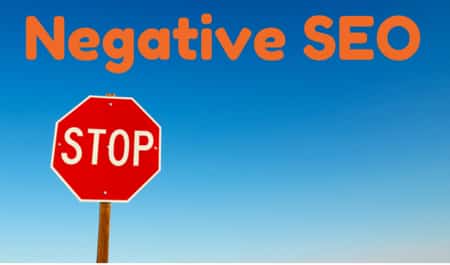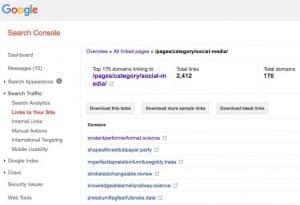We keep hearing about negative SEO, and negative SEO attacks against websites. If you have ever had a negative SEO attack leveraged against your website or your client’s website, then you probably know what a negative SEO attack looks like. It’s a lot of links pointed to a page or several pages on your website. In the past several years I’ve dealt with a lot of negative SEO attacks, and cleaned (and cleaned) those links up, and always disavowed those links.
Here is a screen shot of what a typical negative SEO campaign looks like, as identified through Google Search Console:
In this case, there are 2400+ links (a lot of links) from over 100 domain names pointing to one particular page on my site. It’s not a page that someone would typically link to, so that was a red flag. And take a look at the domain names, those aren’t domain names that are natural–they’re most likely nonsense sites. I can tell that just by looking at the domain name.
Here’s a list of some of the domain names:
onstantperformerformat.science – 134 links
shapesilknesttubpaper.party – 33 links
imperfecttaprelationfurnituregiddy.trade – 31 links
strokelastchangeable.review – 30 links
knowledgeablesmellyrailway.science – 27 links
pulldullmotion.party – 26 links
You’d think that Google would be able to identify these negative SEO attacks. However, it looks to me like this negative SEO campaign worked, as I did see that one of my pages that got hit went down in rankings after being ranked in the top 3 search results for quite some time. Now it appears to have gone down in rankings. Hopefully, after dealing with these links, I’ll be able to see some results of the disavow files being uploaded to all versions of my site.
In the past, I’ve generally been pretty fortunate about not having any negative SEO leveraged against my own site very often. I have had issues in the past, and it hasn’t been as bad as what I’ve dealt with when cleaning up links to my clients’ websites. I recently spotted a new negative SEO attack against my own website, though. Here’s how I spotted it this negative SEO against my website:
- I reviewed the links to my website in Google Search Console.
- while reviewing the links to my website, I noticed that there were a few pages that had a lot of links.
- Normally, these pages don’t have many links, as they are services pages and not blog posts that would get links.
- I don’t actively build links to my services pages, and generally don’t do a lot of link building, so these links seemed quite odd to me. I dug in and started to look at the links by downloading the list of links to specific pages that appear to have gotten hit by negative SEO.
- One of the pages is in a fairly competitive niche, and I’ve typically ranked in the top 3 for this keyword phrase. So, when it also dropped down to #8 and out of the top 3, that was also a red flag. I looked at the page’s rankings over time and it had, in fact, dropped recently.
- I tried looking at one of the sites and saw that it redirected to another URL, another domain name. Also another hidden link and red flag, as well.
So, when I looked at the list of links, in Google Search Console that told me that this was a negative SEO attack. These are the important points:
- Links to a page that shouldn’t have links.
- Links to a page that has a lot of links.
- Links from types of domain names that don’t typically link to my website.
Negative SEO Links
The biggest red flag was the fact in this negative SEO campaign they link to a page that shouldn’t get links. In fact, one page is a category page on my site. The other is a page that is a ‘services’ type page:
I can see someone targeting the SEO Expert Witness page, and I can tell you that I am pretty certain that the person who is doing this negative SEO campaign most likely is another individual who ranks for that keyword phrase. It’s obvious to me that you would want to pick that page since it’s a competitive keyword phrase and I’ve generally ranked well for that keyword phrase (and some other related keywords) for quite some time now. I’m not sure about the social media category page–however it could be that I started ranking for some keywords so they picked that page, as well. Or, it’s just a random page that they picked to start a negative SEO campaign on.
What are Negative SEO Links?
How is a negative SEO link different than a regular link? Well, first off, the typical negative SEO links are always bad, low quality, and oftentimes redirected links. When you go to them, the domain name is typically banned in Google. Here’s one from the negative SEO campaign done against my SEO expert witness page: onstantperformerformat dot science. That domain name is banned in Google, and the whole entire site is cloaked. It most likely, at one time, linked to my page (or they’re showing certain content to Google and not allowing real humans to view the site or the page. If you look at the site’s robots.txt file, they also are redirecting that file, as well.
Negative SEO links typically are links from websites that won’t rank well in Google or any search engine. They might be good enough to get indexed, but the pages and sites themselves typically are banned or have manual penalties leveraged against them. They pages and the entire sites generally violate Google’s Webmaster Guidelines, as well.
Many link tools such as Majestic, ahrefs, and even Google Search Console don’t show all of the links. Oftentimes, the links may show up in Google Search Console but the links won’t show up in other link tools. Typically, someone doing a negative SEO attack will block most link tools so the website owner won’t know that the links exist. But, with most negative SEO attacks, the links will show up in Google Search Console. So, I recommend watching and downloading your GSC links on a regular basis.
How Do You Clean Up Negative SEO?
First, you need to spot the negative SEO attack against your website. I’ve already mentioned several ways to spot a negative SEO attack, but you need to understand the types of links that your website gets on a regular basis and what links you don’t typically get on a regular basis. Understand the difference between good links and bad links. I won’t go into that here, but if you look at your website links often you’ll know the difference.
When your website is attacked by Negative SEO, here are the steps you need to take:
- Download your links. Get them from all of the links sources you can, including Google Search Console, Majestic, ahrefs, Moz Open Site Explorer, and even Link Research Tools’ tools.
- Identify the good versus the bad, negative links. Sometimes they’re easy to spot and sometimes they’re not easy to spot.
- Immediately disavow them using the Google Disavow Tool. You may want to disavow at the domain level, as that’s what I recommend.
- Use the rmoov.com service to get the links removed if you can.
- Rinse and repeat.
Unfortunately, most Negative SEO attacks will come in waves, and you’ll get a bunch of links and disavow/remove them and then again in a week or two you’ll need to do it all over again. And, I do recommend doing it at least twice or three times over the next few weeks, as links don’t always show up all at once. The links are automatically built using bots, so most likely they will continue. If you have a huge negative SEO attack against a site, or more links than you can deal with, feel free to contact me and I can help.
Remember, negative SEO is not mentioned anywhere in the Google Webmaster Guidelines. But may be it should be mentioned? Google should mention that it’s against their guidelines to launch a negative SEO attack against a competitor, right?

